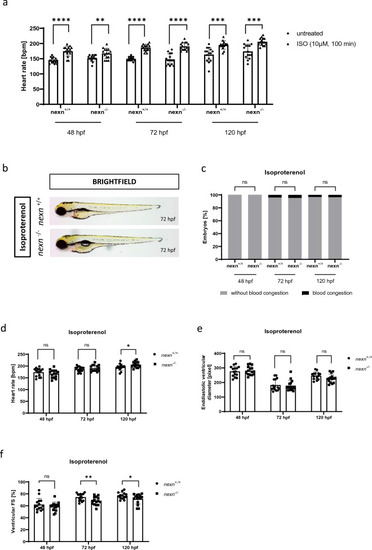
Increasing heart rate does not cause severe changes in cardiac functionality. (a) Isoproterenol treatment increases heart rate in nexn+/+ and nexn−/− embryos at all developmental stages (N = 3, n = 14/15, mean ± SD, 48 hpf nexn+/+: p < 0.0001, 48 hpf nexn−/−: p = 0.0085, 72 hpf nexn+/+: p < 0.0001, 72 hpf nexn−/−: p < 0.0001, 120 hpf nexn+/+: p = 0.0002, 120 hpf nexn−/−: p = 0.0001 using two-tailed t-test). (b) Brightfield images do not reveal phenotypical differences between nexn+/+ and nexn−/− embryos at 72 hpf. (c) Percentage of embryos showing phenotypical abnormalities does not differ between nexn+/+ and nexn−/− embryos at 48, 72 or 120 hpf (N = 3, mean ± SD, p > 0.9999 for all using Mann–Whitney test). (d) Heart rate of nexn−/− embryos is at a similar level as in nexn+/+ embryos at 48, and 72 hpf but increased at 120 hpf (N = 3, n = 15, mean ± SD, 48 hpf: p = 0.3112, 72 hpf: p = 0.3690, 120 hpf: p = 0.0350 using two-tailed t-test). (e) Increased heart rate does not affect enddiastolic ventricular diameter at 48, 72 and 120 hpf (N = 3, n = 15, mean ± SD, 48 hpf: p > 0.9999, 72 hpf: p = 0.7588, 120 hpf: p = 0.0701 using two-tailed t-test). (f) Analysis of ventricular fractional shortening does not show altered heart contractility in nexn−/− compared to nexn+/+ embryos at 48 hpf (N = 3, n = 15, mean ± SD, p = 0.3284 using two-tailed t-test) but reduced fractional shortening at 72 and 120 hpf (N = 3, n = 15, mean ± SD, 72 hpf: p = 0.0099, 120 hpf: p = 0.0498 using two-tailed t-test). FS fractional shortening, ns not significant, *p < 0.05, **p < 0.01. Exact values (mean ± SD) are shown in Supplementary Table 1.
|

